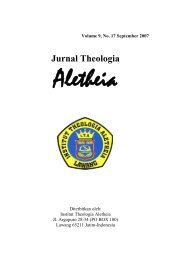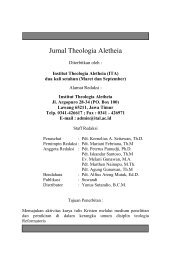download - Sekolah Tinggi Theologia Aletheia Lawang
download - Sekolah Tinggi Theologia Aletheia Lawang
download - Sekolah Tinggi Theologia Aletheia Lawang
Create successful ePaper yourself
Turn your PDF publications into a flip-book with our unique Google optimized e-Paper software.
93<br />
Secondly, if Gerhardsson is right, free-floating parables are<br />
not found in the Jesus traditions, with the possible exception of the<br />
parable of the rich man and Lazarus. 119 In other words, the<br />
evidence provided by the Synoptic Gospels points in the direction<br />
of contextually-anchored parables. The settings provided by the<br />
evangelists are to be taken seriously as they are the earliest<br />
witnesses to what the parables could have meant. 120 These settings<br />
provide moorings in an otherwise tumultuous hermeneutical sea.<br />
The belief that many parables are ‗naked narratives with<br />
indeterminate messages‘ 121 therefore depends on considerations not<br />
found in the Gospels, but arises, most probably, from the agendas<br />
of certain schools of interpretation. 122 Indeed, Gerhardsson insists<br />
that the parables were given to illuminate aspects of Jesus‘<br />
kingdom message. 123<br />
Thirdly, the frame and the parable cohere well structurally, at<br />
least in terms of rabbinic teaching methods. Blomberg argues that<br />
they conform to the rabbinic method known as yelammedenu<br />
rabbenu (i.e., ‗let our master teach us‘) and this has a four-part<br />
structure: 124<br />
(1) Question on a scriptural text (vv. 25-7);<br />
(2) A second text given to illuminate (v. 28);<br />
(3) The exposition (in this case, the parable); and<br />
(4) The final remarks (v. 37). 125<br />
119<br />
Gerhardsson, ‗Parables out of their frames‘, pp. 325-6.<br />
120<br />
Ibid.,p. 322.<br />
121<br />
Ibid., p. 333.<br />
122<br />
This may be the desire to give the parables autonomy, treating them as naked<br />
texts and divorcing them from the particularity of history, especially that of<br />
Jesus of Nazareth. This fits in well with the postmodern agenda and the antiestablishment<br />
agenda too.<br />
123<br />
Gerhardsson, ‗Parables out of their frames‘, p. 329.<br />
124<br />
Blomberg, Interpreting the Parables, p. 231.<br />
125<br />
On the possibility of Jesus‘ using rabbinic methods, see B. Gerhardsson,<br />
Memory and Manuscript, Uppsala: Gleerup, 1961; R. Riesenfeld, The Gospel<br />
Tradition, Oxford: Blackwell, 1970; R. Riesner, Jesus als Lehrer, Tübingen:<br />
Mohr, 1981; and most recently, S. Byrskog, Jesus the Only Teacher: Didactic




